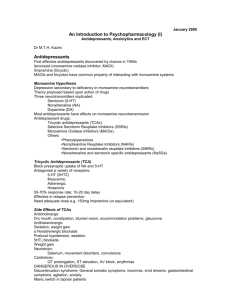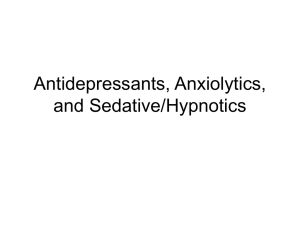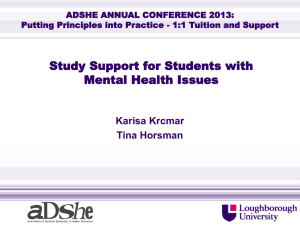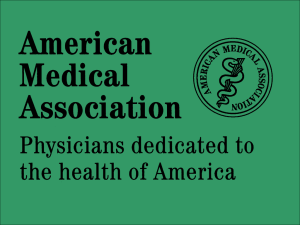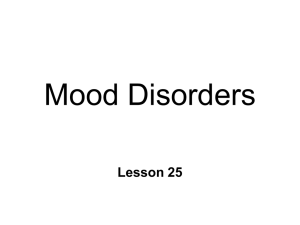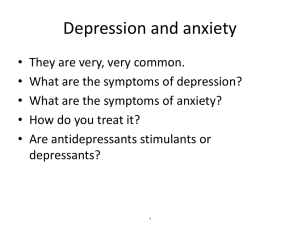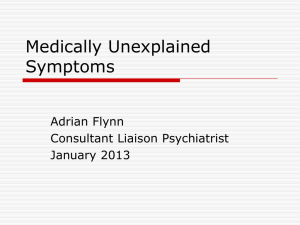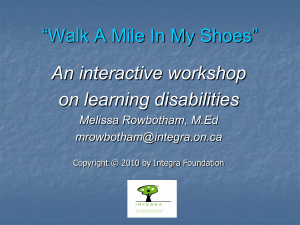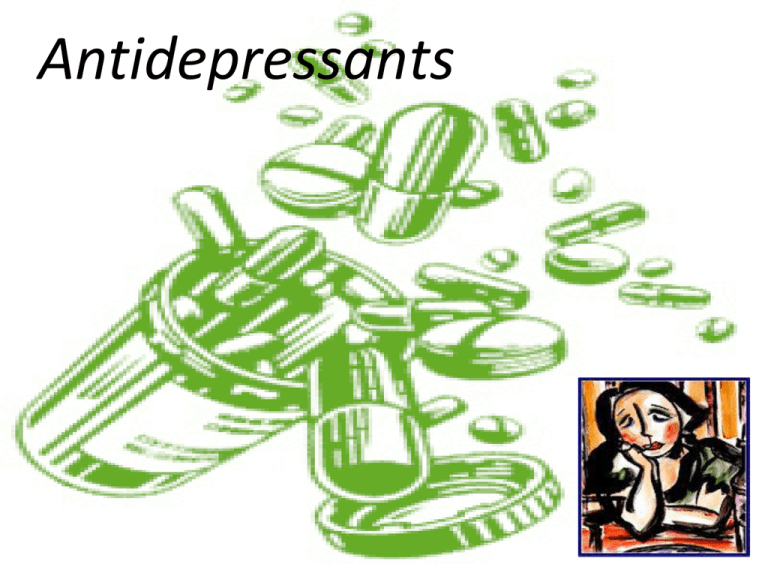
Antidepressants
Depression Criteria
Five or more of the following, nearly every day, in the same two-week span. Must
include one of first two. Must cause significant distress/impairment. Cannot stem
from medication, drug abuse, medical condition, or regular bereavement.
•
•
•
•
•
•
•
Depressed mood throughout most of day
Diminished interest/pleasure in almost all activities
Large increase/decrease in appetite
Insomnia or excessive sleeping
Restlessness or slowed movement
Fatigue or diminished energy
Feelings of worthlessness or excessive/inappropriate
guilt
• Difficulty thinking, concentrating, and making decisions
• Recurrent thoughts about death (not just fear of dying),
recurrent suicidal ideation, suicide attempt
Some Forms of Depression
• Unipolar Disorder
– Recurring episodes of major depression
• Bipolar Disorder (a.k.a. Manic-Depression)
– Alternating periods of mania and depression
Manic symptoms
•
•
•
•
•
•
•
•
Euphoria and/or irritability
Distractibility
Insomnia
Grandiosity
Flight of ideas
Increased activity
Excessive speech
High-risk activity
Some Forms of Depression (cont)
• Dysthymia
– Depression with fewer or less
severe symptoms, but causing
persistent (2 yrs or more)
dysfunction
• Seasonal Affective Disorder
– Depression dependent on season
and/or length of day
Economic costs of depresssion in US in 1990
$11.7 billion
Absenteeism
(26.8%)
$8.3 billion
Inpatient care
(19.0%)
$2.9 billion
Outpatient care/partial care
(6.6%)
$12.1 billion
Decreased
Productive Capacity
(27.7%)
$7.5 billion
Death from Suicide
(17.1%)
Andrews & Nemeroff, Am. J. Med., 1994
$1.2 billion
Pharmaceutical costs
(2.8%)
ECT Shock (70-130 V)
• delivered unilaterally
• increases NE and 5-HT
• 9 to 10 sessions
• Side effect: memory dysfunction
• generally returns fully
SOME EARLY TREATMENTS
Trephination:
cure
epileptic seizures,
migraines and mental
disorders
Other Uses….(TMS)
•
•
•
•
•
•
•
•
OCD
Diabetic nerve pain
Panic attacks/disorder
Chronic tension headaches
Social phobia
Premature ejaculation
Emotional problems
Change in appetite and sleep
patterns
• Low mood
• Loss of interest in people and
activities
• Decreased sex drive
• Feelings of guilt or
worthlessness
• Suicidal thoughts
• Difficulty concentrating
• Slowed thinking
• Posttraumatic stress disorder
Physiological Correlates: Cortisol
• 50% of depressed patients have
elevated cortisol levels.
• Cortisol’s primary functions are to
increase blood sugar through
gluconeogenesis; suppress the
immune system: and aid in fat,
protein and carbohydrate
metabolism
• Saliva from infants of mothers
with depression history has
higher cortisol levels
• 5-HT and other NTs indirectly
affect cortisol levels
• Depressed subjects
frequently show early
onset but reduced levels
of REM sleep
• Cholinergic-aminergic
hypothesis suggests
depressed subjects have
abnormal sensitivity to
ACh and amines, which
regulate sleep cycles
REM latency (minutes)
Physiological Correlates: Sleep and REM
Five age groups (years)
Antidepressants
• Biogenic Amine Hypothesis: deficit of NE and 5-HT function
• Most antidepressants work on one or both of these systems,
raising NT levels immediately
• Therapeutic response requires weeks of antidepressant use
• Major categories
– Tricyclics
– MAOIs
– SSRIs
– Atypicals (serotonin-norepinephrine reuptake inhibitors)
• All categories have roughly equal efficacy for depression, but
differ in side effects and toxicity
Tricyclics
• Imipramine (a TCA) accidentally found to help
depression in 1960s
• TCAs also have anxiolytic and analgesic action
• Mechanism: Block NE and 5-HT reuptake, also
blocks ACh receptors
• Many anticholinergic side effects (e.g. dry mouth,
blurred vision, constipation)
• Can be cardiotoxic with overdose
• Can impair attention, motor speed, dexterity,
memory, and cause sedation
Monoamine Oxidase Inhibitors
• Introduced in late 1950s
• Blocks MAO breakdown of monoamines, increasing NT
available in terminals
• Can be dangerous because MAOs also breakdown substances in
the body (e.g. tyramine in aged cheese) that can be toxic at
high levels
• Some MAOIs are irreversible, while others temporarily
inactivate MAOs
• Useful in those not responding to other antidepressants, and
those with many anxiety and phobic symptoms
• Can have severe interactions with other drugs
Selective Serotonin Reuptake Inhibitors
• Used since mid-80s, especially through 1990s
• Selectively inhibit reuptake of 5-HT
• Few sedative and cognitive side effects?
• Side effects include headache, GI discomfort,
nervousness, insomnia, tremor, sweating,
sexual dysfunction, but overall less severe
than TCAs and MAOIs
• Long term use or combination with some
other drugs can lead to “serotonin
syndrome” including exaggerated side
effects, plus cognitive impairment and other
physiological problems
Zoloft (Sertraline)
Prozac (Fluoxetine)
Potency
• Paxil is the most potent SSRI available
• The reason it is effective is unclear
• In a comparison with…
fluoxatine(Prozac)
setralin(Zoloft)
paroxetine (Paxil) had
significantly more withdrawal effects
(The British Journal of Psychiatry (2000)
176: 363-368)
The clinical implication is that adverse
effects upon discontinuation is not
relapse, but effects from the
medication
Paxil and Children
• The use of paroxetine was
never approved for use in
the treatment of children
and adolescents under 18
• Federal law does not
require “off-label” studies
to be available
• In 2002 2.1 million
prescriptions were written
for children in the U.S.
• Generated $55 million in
sales to children
Wide spread use
• Used in over 100 countries as an antidepressant
• Used in over 80 other countries for OCD and Panic
disorder
• Over 80 million patients are prescribed Paxil
– 2.1 million children in USA in 2002
• After 1998, Paxil is the second most prescribed pill for
anxiety disorder
• Paxil is a certified treatment in over 70 countries for
anxiety disorder
• In 2003, Paxil is certified from FDA for social Anxiety
disorder as controlled-released Tablets and cures for
premenstrual dysphoric disorder (PMDD)
Atypicals
• Atypical refers to variation from
typical TCA structure
• Most popular is bupropion (a.k.a.
Wellbutrin, Zyban) – a
psychostimulant
• Bupropion inhibits DA and NE uptake,
not 5-HT
• No sexual dysfunction, but can cause
anxiety, restlessness, tremor,
insomnia, weight loss
• Also used for smoking cessation
Possible Mechanisms
• Increase in monoamine levels
• Desensitization of autoreceptors
• Reduction of stress hormones
• Stimulation of neurogenesis
• Placebo
SSRI Withdrawal Symptoms
•
•
•
•
•
•
•
Nausea
Dizziness
“The Zaps”
Flu-like symptoms
Vertigo
Depression
Mania
• Anxiety
• Sleep problems
• Gastro-intestinal
problems
• Sweats
• Sensitivity to light and/or
sound
Withdrawal model ~ patients continue take to avoid
withdrawal effects.
Serotonin Syndrome
• Resembles extreme form of SSRI
overstimulation
–
–
–
–
–
–
–
–
Irrational euphoria
Agitation
Confusion
Gastronintestinal problems
Fever/chills
Poor coordination
Muscle spasms
Death
• Exacerbated by MAOI’s
Critiques of Antidepressants
• Marketing to people who don’t need
• Medicating problems
• Homogenizing personalities
• Pressure to use
• Concealing side effects
• Long-term effects


